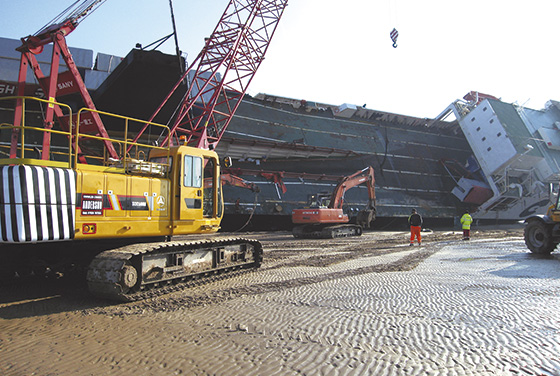Let´s go ahead
Going through the instabilities that limited sales in the first half of the year, the market of crawler cranes has positive expectations for next years

From January to May, 2014 no crawler cranes were sold in Brazil. This alarming information may be confirmed in the data issued by the Ministry of Development, Industry and Foreign Trade (MDIC) and by the Federal Revenue. As we will see, some of the main manufacturers of this area confirm a low-exciting current scenario for this type of equipment. But in contrast to what could be supposed, they have very favorable points of view for the future.
To understand this situation, it is necessary to establish the context of downward leveling that the market is currently living. “In fact, this area always had a low participation in Brazilian market, mainly due to the priorities considered by rental companies in their acquisitions. Their equipment needs mobility, what leads to a preference for wheel cranes”, says Luciano Dias, sales vice-president of Manitowoc in Brazil.
Enlarging data to be analyzed, Elton Lima—commercial director of Sany—points out that between 2010 and 2012 the demand for crawler cranes has grown approximately 45 percent per year, occurring a heavy reduction during the years that followed. “This was mainly due to the areas of wind power and of construction and operation of new shipyards”, says him. “But in 2014 we had seen an atypical year since no new crawler crane with lattice boom entered in Brazil, indicating a lack of new long-term works in the country.”
NORMALITY
In this scenario there is also a question of perspective. For César Schmidt, manager of the crawler and wheel crane area of Liebherr in Brazil, the years of 2010 and 2011 were “extraordinary”, with a significant increase in the number of crawler crane acquisitions, mainly to attend the works of stadiums for the World Cup and to improve the infrastructure needed for these games and for the country itself. “Now we can say that the market came back to the normality”, points him.
On the other hand, Schmidt says that it is possible to see an interesting market potential in crawler cranes for tower erection and rotor assembly in wind power parks. The expert explains that this type of equipment has specific features to attend these operations, such as the capacity of lifting heavy loads to great heights in places with a lot of wind. “For these operations, crawler cranes have to preferentially have a lower width to make easy their motion in the accesses of wind power parks, which are quite narrow”, says him. “In addition, they must have moving conditions in maximum configuration and must have systems of quick assembly and disassembly, since they remain in each tower a few days—when not of a few hours—demanding then a new displacement.”
Commercial director of Terex, Hebert Karly sees that machines with capacity up to 300 tons are quite used in the Brazilian market. Specifically, the executive highlights the models of 250 ton, which fit better to the needs of most works in the country. “Since they are very large machines that demand high investments, heavy contractors and industries are the focus of this product”, says him. “Some examples of users are metal shops, shipyards, concrete precast, metallic structures and silo manufacturers, petrochemical, machining and mining companies”, completes him, highlighting also the erection of wind power towers that—as pointed by Schmidt—is becoming an important market for equipment above 400 ton.

Av. Francisco Matarazzo, 404 Cj. 701/703 Água Branca - CEP 05001-000 São Paulo/SP
Telefone (11) 3662-4159
© Sobratema. A reprodução do conteúdo total ou parcial é autorizada, desde que citada a fonte. Política de privacidade














